Making a watch glow in the dark sounds simple enough, but watchmakers have spent over a century experimenting with different methods to get it right. 1908 radium paint was the go-to solution, slathered onto dials and hands for round-the-clock visibility. It worked incredibly well—until we realized it was highly radioactive and decided maybe that wasn’t the best idea. By the 1970s, radium was out, and Super-LumiNova stepped in, offering a safe, non-toxic way to light up watch dials.
These days, Super-LumiNova is everywhere, whether it’s called LumiBrite (Seiko), Chromalight (Rolex), or some other brand-specific name. It charges under light and glows for hours—when appropriately applied. But we’ve all seen lume that fizzles out in less than an hour, which is precisely why it’s not a perfect system.
Enter tritium gas tubes – the Goldilocks of watch illumination. Unlike painted lume, tritium doesn’t need an external light source. It glows perpetually thanks to a chemical reaction that slowly releases electrons, keeping the phosphorus inside the tiny glass tubes lit for decades. The trade-off? Tritium watches cost a little more and don’t have that initial “torch-bright” glow of freshly charged Super-LumiNova. However, unlike painted lume, tritium keeps perpetually glowing for up to 25 years. Despite its advantages, tritium remains a niche feature in the watch world, used by only a handful of brands willing to embrace its long-term benefits. This guide highlights the best tritium watches that we’ve ever reviewed and we hope you find it helpful. Please let us know your thoughts in the comments below or if there are any other tritium watches out there you’d like us to review.
ProTek Series 1000 Carbon Dive

| Case Size: | 42mm x 49mm x 14mm |
| Movement: | Miyota 2S60 (Quartz Movement) |
| Battery Life: | 10 Years |
| Crystal: | Sapphire Crystal |
| Price: | $495 |
ProTek might be a newer name, but their watches come with some serious pedigree. Founded by Barry Cohen after bringing Luminox to the watch world, ProTek is in the business of making ultra-durable, high-performance watches for military personnel, law enforcement, and first responders. That commitment to rugged reliability has already earned them an official designation from the USMC. ProTek watches feature lightweight but tough materials, a 10-year battery life, and T25 tritium illumination—all of which come together in one of the brand’s flagship models, the Series 1000 Carbon Dive. Mike got the chance to go hands-on with this model while chatting with Cohen on the Two Broke Watch Snobs podcast, where they dug into the brand’s history and mission.
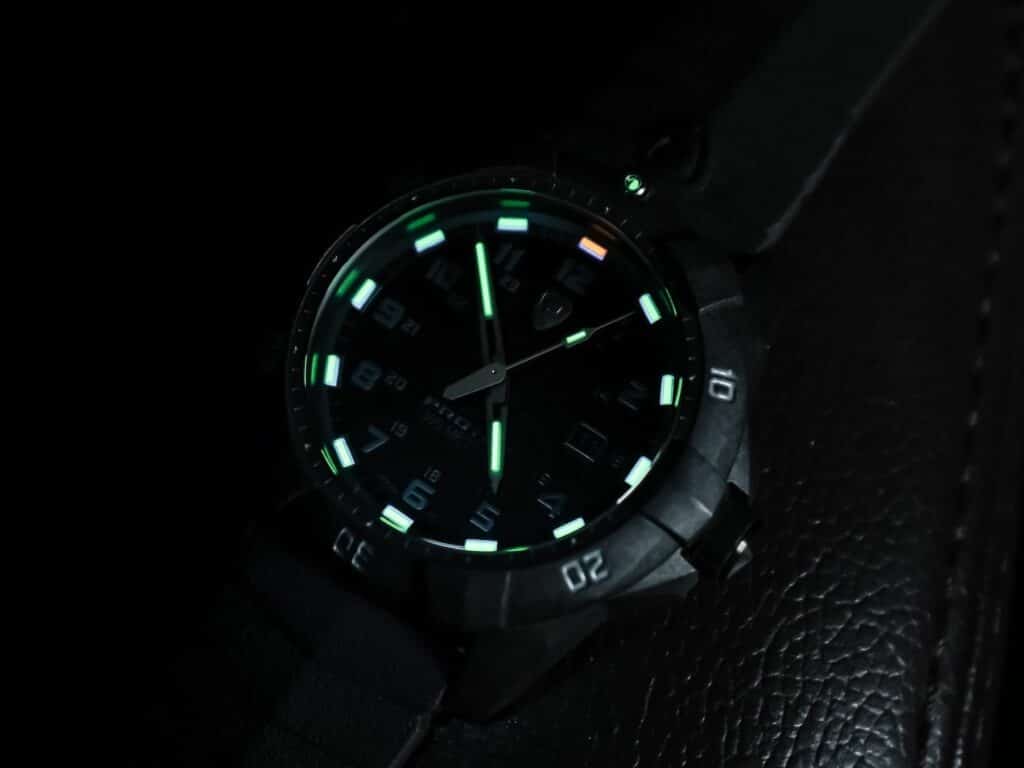
The ProTek Series 1000 Carbon Dive leans into its 42mm carbon composite case, keeping things light on the wrist without feeling cheap or flimsy. Paired with a 60-click unidirectional bezel and a 316L stainless steel crown, the watch delivers a tool-focused design that doesn’t tip too far into “mall-ninja tactical.” The red accents on the dial add just enough contrast to keep things interesting, and the whole thing feels reassuringly solid despite its light weight. Inside the watch, the Miyota 2S60 quartz movement keeps time within +/- 20 seconds per month, which makes it an easy grab-and-go option for anyone who doesn’t want to fuss over a mechanical diver. But what really makes this watch stand out is the T25 tritium illumination system, ensuring uninterrupted low-light readability that lasts for 25 years.
Want a deep dive into the tech behind tritium illumination? Check out episode #276 of the Two Broke Watch Snobs podcast, where Barry Cohen breaks down the intricate process of manufacturing and integrating tritium gas tubes into a watch design. Other standout specs include a sapphire crystal, 300m of water resistance, and a durable rubber strap, making the Series 1000 Carbon Dive a serious contender in the tritium-equipped diver space. And here’s the kicker – you can snag one for under $500 from the official Protek site. When you stack up the specs, capability, and price, the ProTek Series 1000 Carbon Dive is tough to beat.
Traser P67 Officer Pro Automatic
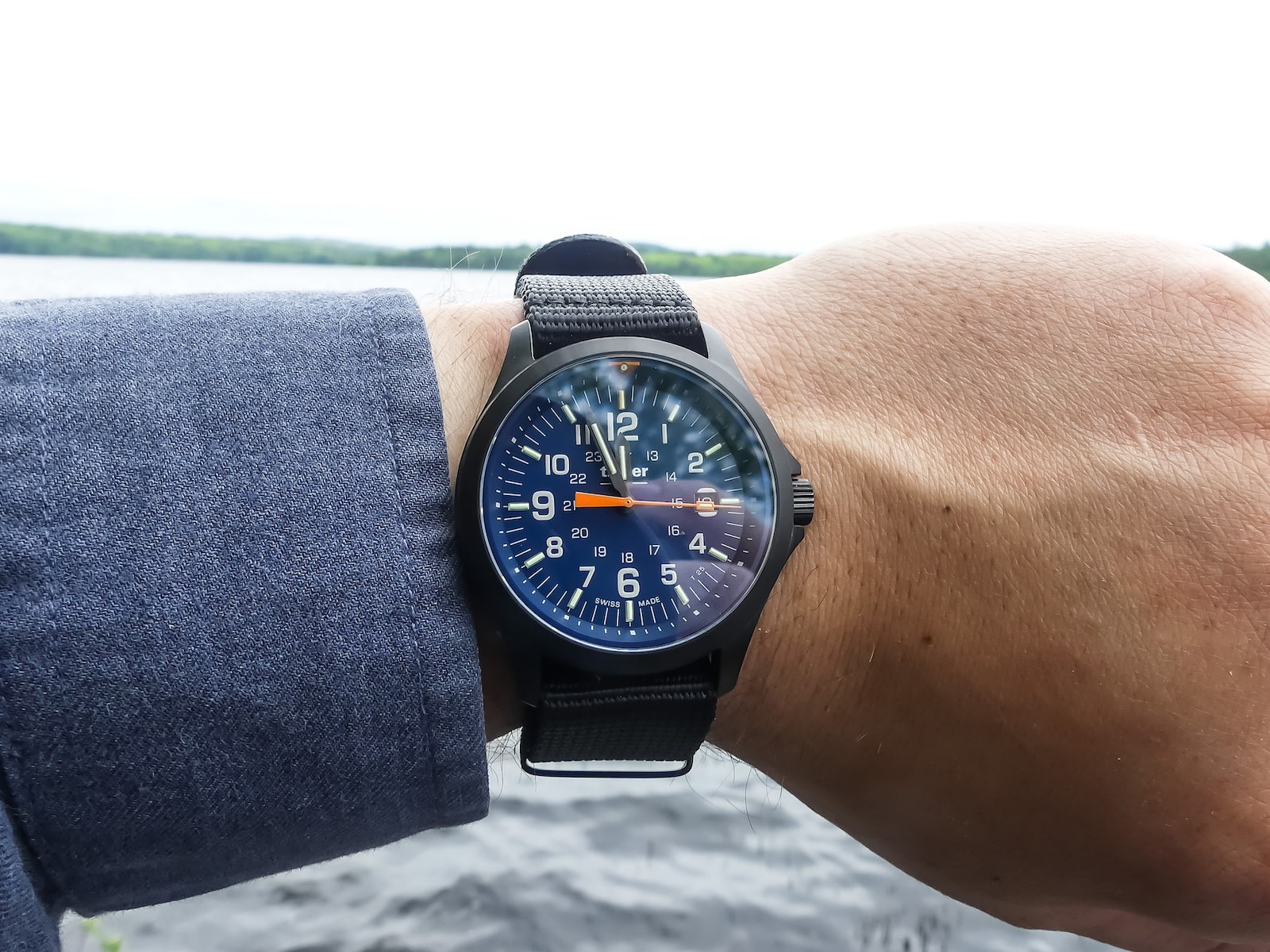
| Case Size: | 42mm x 49.5mm x 10mm |
| Movement: | Ronda 715 (Quartz Movement) |
| Battery Life: | 5 Years |
| Crystal: | Sapphire Crystal |
| Price Range: | $500 to $640 |
Traser operates as the in-house brand of mb-microtec, the manufacturer behind the tritium gas tubes supplied to various watchmakers. The P67 Officer Pro Blue takes that industry expertise and focuses it into a field watch design that stays practical without looking overly tactical. It features a 42mm PVD-coated stainless steel case that our review team felt wore better than other similar 42mm timepieces. This is primarily due to its 49.5mm measurement and slim 10mm case, highlighting its emphasis on everyday practical wearability.
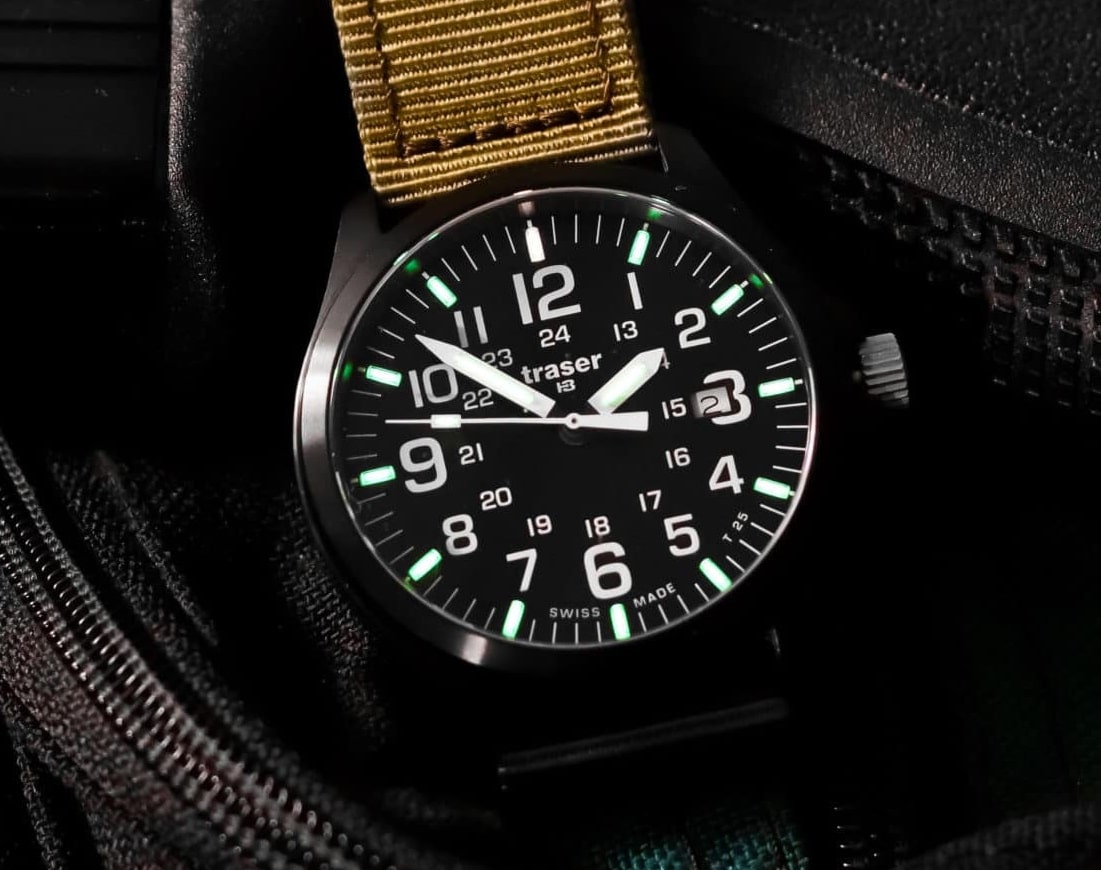
A deep-set dial and inward-sloping chapter ring also helps balance the visual impact of the watch, which really makes it great for everyday wear. Legibility is solid despite the black hands blending into the dark blue dial – something our review team was initially worried about upon first wearing the watch. That’s because while the contrast isn’t perfect in bright conditions, the embedded tritium tubes make up for it by enhancing the legibility of the hands. Long minute markers make checking the time quick, and the orange accents on the second hand and tritium pip add a tiny but welcome bit of personality. I also found that the nylon strap sat securely and didn’t feel like an afterthought.
Unlike earlier Traser models, which leaned heavily into tactical or military styling, the P67 Officer Pro Blue refines the formula into something more wearable for daily use. It also avoids the plastic case elements in some older Traser models, opting for an all-metal build that enhances durability without adding unnecessary bulk. The P67 Officer Pro Blue stands out by keeping the field watch format intact while delivering long-lasting illumination, making it one of the most balanced choices for tritium enthusiasts. Be sure to check out our full review of the Traser P67 Officer Pro. We also encourage you to visit the official Traser site to see all the different dial variations that are available where prices range from $500 to $640 depending on the specific model you’re looking at.
Marathon TSAR
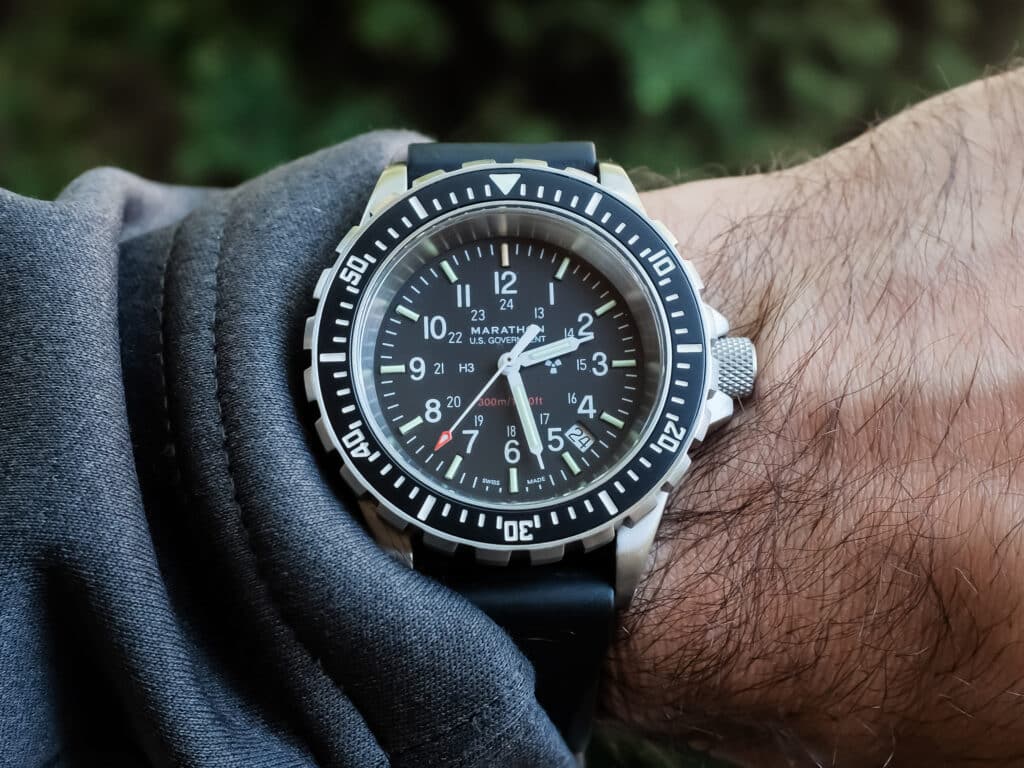
| Case Size: | 41mm x 48mm x 14mm |
| Movement: | ETA High-Torque FØ6 (Quartz Movement) |
| Battery Life: | 5 Years |
| Crystal: | Sapphire Crystal |
| Price Range: | $1350 – $1600 |
Marathon is about as real as it gets when it comes to producing rugged military watches. The TSAR is one of their most popular models, and it was originally built for Canadian Search and Rescue teams. At 41mm, the stainless steel case is all business—brushed, hefty, and built for work. Its 120-click bezel is heavily textured and made to be used with heavy gloves and in extreme conditions (like freezing weather). The Tritium lume stays visible all night and with a 25-year half-life, it’s built for long-term reliability. The placement of the date window at 4:30 is practical since it doesn’t interrupt the timepiece’s legibility (even if the date window’s white background pops a little more against the black dial than we’d prefer). The ETA High-Torque FØ6 quartz movement delivers precision at -0.3 to +0.5 seconds per day, built to push the hefty hands along with those tritium tubes.
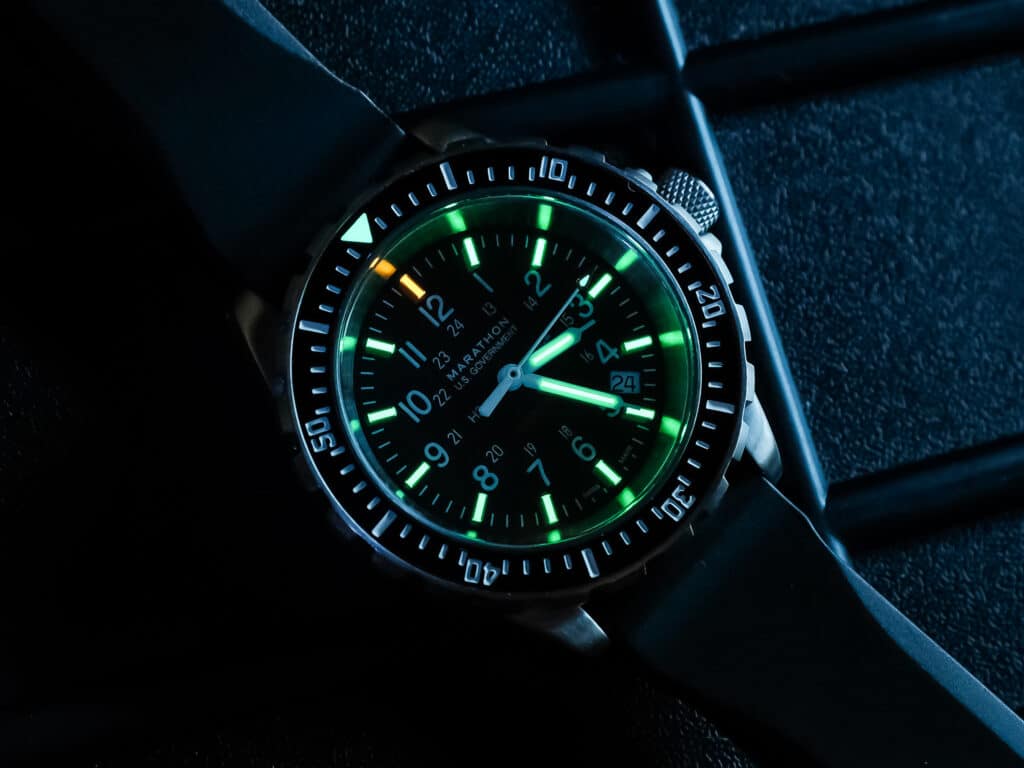
During hands-on testing, our review team found that wearing the Marathon TSAR felt like strapping on a piece of mission gear. It’s dense, tool-like, and no-nonsense. While Marathon offers the TSAR on a bracelet, the version we tested featured rubber strap. We found the quality of the strap to be on par with the quality of the rest of the watch, prioritizing functionality, comfort, and durability. Truthfully, if you’re in challenging environments or even just working up a sweat, the rubber strap would be a better choice over the bracelet since the added heft and extra steps to adjust the sizing would detract from the in-the-moment wearing comfort and reliability.
We found the TSAR delivers a rare combination of overengineered durability, incredible tritium lume, and no unnecessary frills. There’s nothing delicate about the TSAR, and that’s exactly the point. This would certainly be a difficult watch to try and also wear in professional settings, but in the correct casual or (especially) demanding environments, it would fit right in. The 41mm model we reviewed is available on the official Marathon site for $1,300. But for those wanting something larger or smaller, Marathon also makes 36mm and 46mm versions and an automatic alternative for a little more cash. Be sure to head over to our hands-on review for our full testing experience of the Marathon TSAR.
Ball Engineer III King
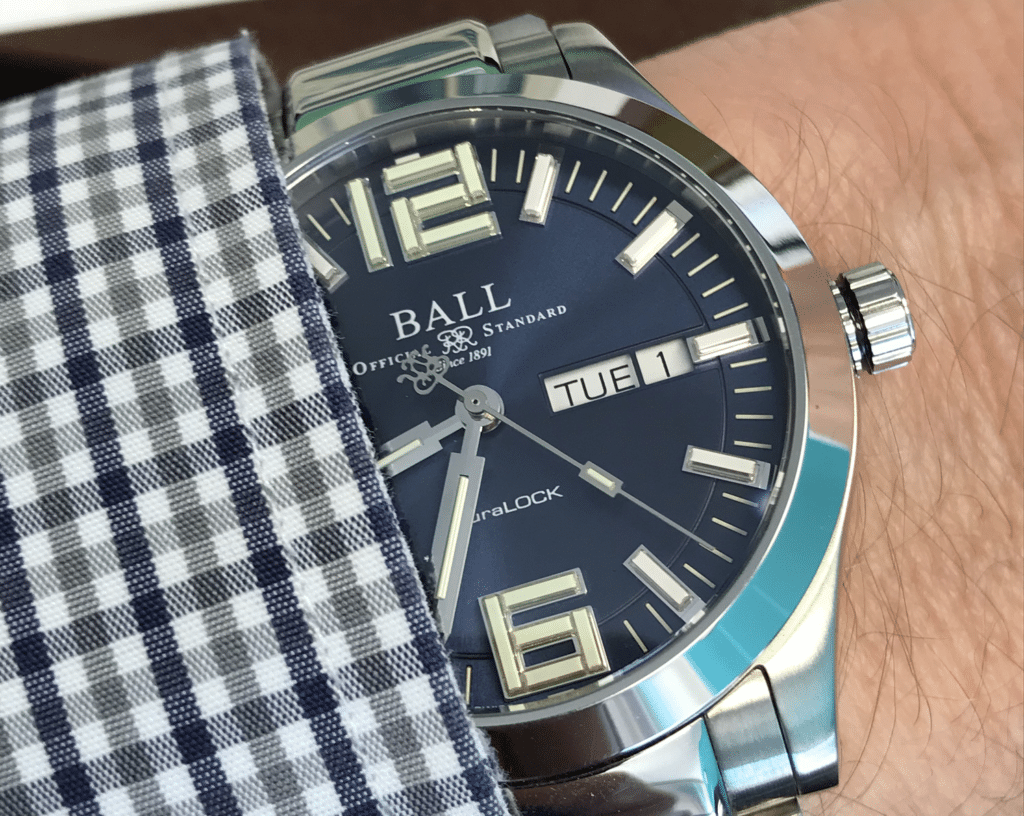
| Case Size: | 40mm x 47mm x 13.6mm |
| Movement: | Ball RR1102 (Automatic Movement) |
| Power Reserve: | 38 Hours |
| Crystal: | Sapphire Crystal |
| Price Range: | $2200 – $2500 |
Ball Watch Company’s marketing leans into astronauts, storm chasers, and extreme adventurers, which is amusing considering the brand originally existed to keep train conductors on schedule. The branding stretch aside, the Ball Engineer III King earns its place through specs, not slogans. While we were testing the watch, we found that the 40mm stainless steel case brings some heft, and the polished bracelet with non-tapering links amps up its wrist presence even more. While measuring the accuracy of the timepiece, we noted that the Ball Caliber RR1102 (based on the ETA 2836-2), ran at an impressive +3.1 seconds per day. The 100m water resistance, DuraLOCK crown, and 80,000 A/m anti-magnetic rating make the watch as functional as it is flashy.
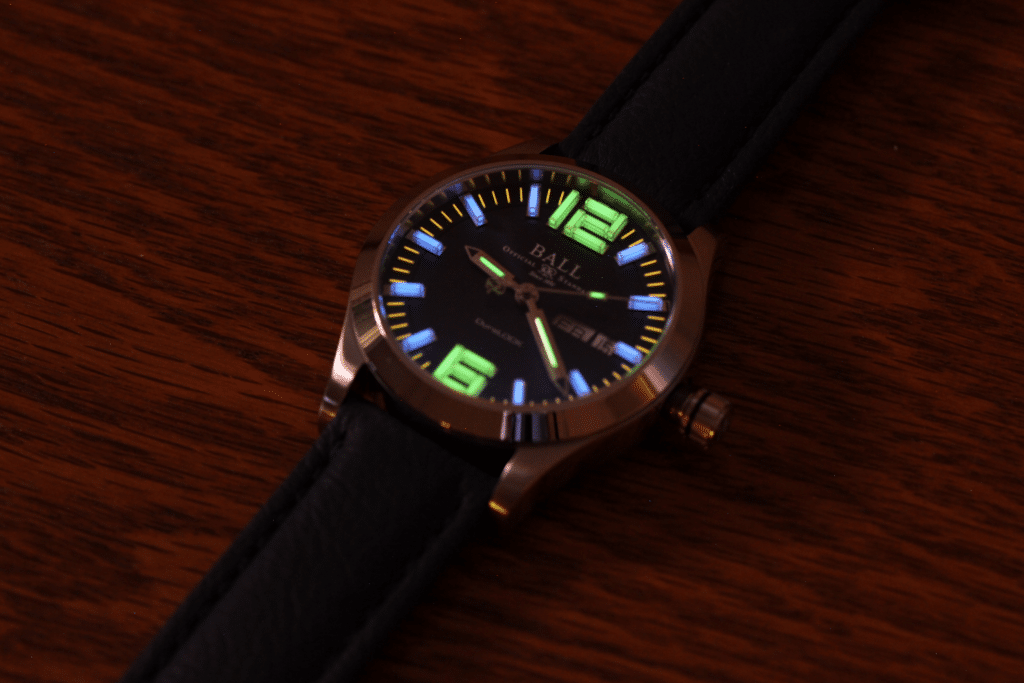
The bracelet leans flashy with polished center links that grab light at every angle, and while there’s no micro-adjustment, two half-links can provide flexibility for a solid fit. While on the wrist we noted that the weight distribution on the watch was quite balanced, preventing it from feeling top-heavy (even on a smaller wrist). Despite the 14.4mm thickness, it wears better than the dimensions suggest. The blue dial adds a mild sunburst effect, but the real spectacle starts when the lights go out. Sixty-four tritium gas tubes stack across the dial, giving it an around-the-clock glow that makes most lume-heavy watches feel underpowered. Some love the bold layout, and others think it looks like something off a children’s glow-in-the-dark craft kit. But it is without a doubt one of the most impressive uses of tritium tubes out there.
Now it’s entirely possible that you love everything about how this watch uses tritium, but maybe there are too many polished surfaces or the heft of the bracelet and the case aren’t for you. Swapping the bracelet out for a leather strap would absolutely tone down those elements. You can read more about the Ball Engineer III King in our full review. If you’re interested in buying it, your best bet will be the official Ball Watches site where the watch is listed for $2,449.

Nathan Schultz is a New Hampshire based writer with a passion for affordable timepieces. He became obsessed with automatic watches in 2019 after learning not all watches have batteries, and quickly fell in love with the joys of collecting and modifying watches and meeting fellow enthusiasts. When not poring over new releases from big brands and microbrands, he can be found putting his tool watches to the test on local hiking trails.
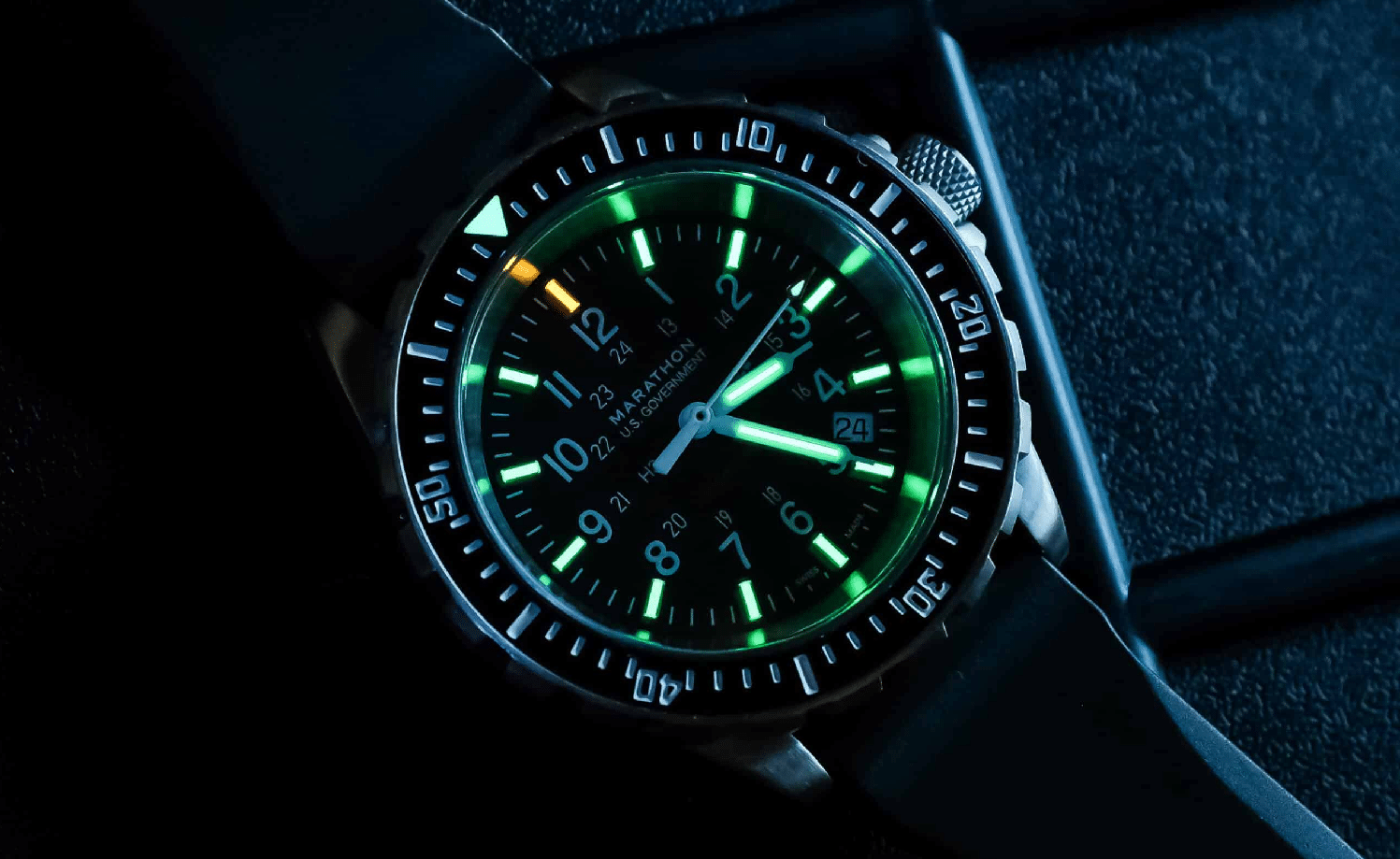
Great article! A good read too. Make an amendment to it though to include the tritium dive watches from Deep Blue. They have an excellent range and no – I don’t work for them or do business with them etc. Etc.
My deep blue triumph automatic SUCKS and loses three mins each week. Customer service for Deep Blue won’t fix under warranty because they cant find record of my purchase which was brought via their website. Terrible customer service.
Deep Blue?
Pretty stunning T100 and good pricing.
Just got one yesterday and pretty impressed with build quality.
Spot on John.
Amazing callout! Will get them on the list during the next refresh/update on here – thank you, Johnny!
-Kaz
I love my Deep Blue Day/Night Patriot. I think I paid 300 with shipping but it was delayed due to an inventory audit. Steve at Deep Blue emailed me when he found out that my order didn’t ship and sent be a free watch strap of my choice.
I am beyond in love wit my Patriot. Its my go to daily watch. Keeps excellent time. The Tritium is bright. I love it.
-JMT
+1 more for Deep Blue. I’ve got a 41mm DayNight that’s become my default “go anywhere, do anything” watch. Water resistant to 500m, uses an NH-35, so replacement parts (or movements) are trivial to find if needed, and was under $300 (plus the sunburst dial is beautiful!). Unfortunately, I think they quit making the 41mm, although I believe they quit making that they one. There is a larger version still available, though.
Deep Blue Recon GMT T100!!!
Good overview. Marathon watch Co pay watches have and have had since the 1990s the current US Government contract. Why? Because their products are built and tested to strict Government specifications.
Does anyone make a 52mm tritium watch ?
Invicta and Aragon have bigger watches around 50mm with T100 tritium. Both using Seiko automatic movements.
Luminox sport timer is what I found to my liking. They also have a bunch of different quartz available
I have had 2 armourlite watches. In 4 months the first one allowed condinsation under the crystal. It was replaced under warranty (took 2 months to get). Second one same thing happened in a few months use. Contacted armourlite, they ignored my issue. At 8months the watch just stopped.
Very frustrating.
I was going to get a Officers model but after reading about your experience has me worried the same thing might happen to Me.
A real shame because I like the look of the watch..
Which dive watch has the most luminosity? Which 1 is the easiest to view at night?
Hi, Colin:
Honestly, since these are all tritium – they’ll all be great for viewing at night. But any of the timepieces which simply feature more tritium tubes than others will have enhanced nighttime visibility – the Ball timepieces we highlight here for example are great for that.
Thank you!
-Kaz
Some brands not included in this list: Aragon (USA), Vostok Europe (Lithuania) and some models by Invicta (USA) use tritium as well.
Wow – I did not realize that Invicta offered Tritium timepiece – great callout!
-Kaz
Aragon isn’t made in USA. Aragon plays the location game by assembling Chinese parts inside the USA. It’s a Hong Kong watch. Even some of the so-called Swiss movements are actually made in China. I’m finished with looking for a bona fide high-quality tritium that doesn’t feed the Chinese communist machine.